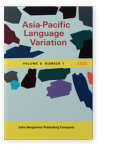Vol. 8:1 (2022) ► pp.106–137
Word order variation in Chinese existential constructions with V-măn
A corpus-based analysis
Under Talmy’s (2000a) framework of Figure and Ground segregation, this paper examines the word order variation between constructions [NPFigure V-măn NPGround] and [NPGround V-măn NPFigure] regarding Chinese existential phenomenon, that is, Mìfēng fēi-măn le huāyuán. ‘Bees swarm in the garden.’ and Huāyuán fēi-măn le mìfēng. ‘The garden swarms with bees.’
In this data-driven study, 263 monosyllabic verbs are investigated and 1456 news texts are collected for a quantitative analysis. This study has successfully identified linguistic factors that can better account for the distributional patterns of the word order alternation in the corpora. Results of the VARBRUL analysis indicate that topicality of the post verbal NP and definiteness of Figure NP play a relatively crucial role in determining the word order choice, while semantic type of verb and animacy of Figure NP are less influential. This paper presents a variationist perspective on the motivations that trigger the use of Chinese existential construction [NPGround V-măn NPFigure].
Article outline
- 1.Introduction
- 2.Focus of this study
- 3.Literature review
- 3.1Topicality of the post-verbal NP
- 3.2Discourse familiarity of the two NPs
- 3.3Word length of the two NPs
- 3.4Animacy of the Figure NP
- 3.5Definiteness of the Figure NP
- 3.6Semantic type of the verb
- 4.Methodology
- 4.1Data sources
- 4.2Sampling
- 4.3Statistical tools
- 4.4Coding
- 4.5Research questions
- 5.Results
- 5.1General distribution of the two constructions
- 5.2Significant factors identified
- 6.Discussion
- 6.1Topicality of post-verbal NP
- 6.2Definiteness of figure NP
- 6.3Discourse familiarity of two NPs
- 6.4Animacy of figure NP
- 6.5Semantic type of verb
- 7.Conclusion
- Acknowledgements
- Notes
-
References
